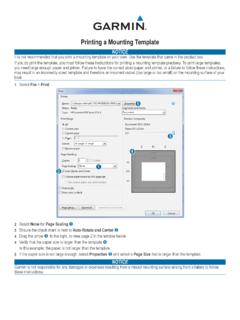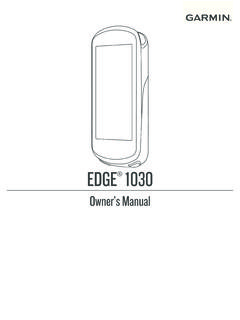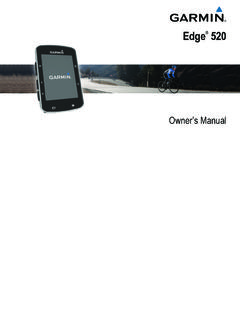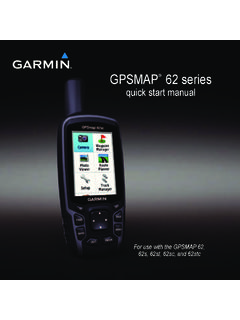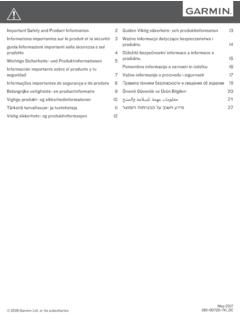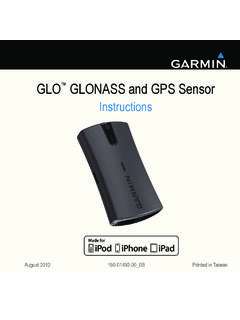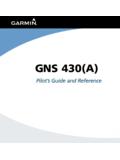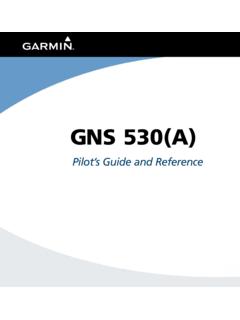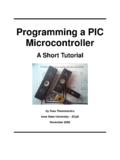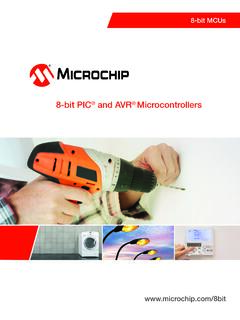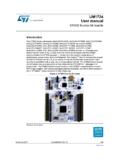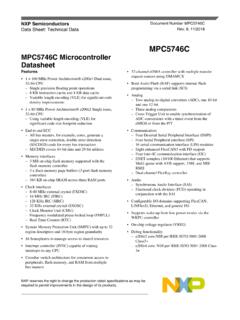Transcription of Lidar Lite v3 Operation Manual 2 and Technical Specifications
1 Table of Contents Lidar Lite v3 Operation Manual and Technical Specifications 1. Laser Safety 1. Documentation Revision Information 1. Lidar Lite v3 Operation Manual Specifications 2. and Technical Specifications Physical 2. Electrical 2. Performance 2. Laser Safety Interface 2. WARNING Laser 2. This device requires no regular maintenance. In the event that the device Connections 2. becomes damaged or is inoperable, repair or service must be handled by Wiring Harness 2. authorized, factory-trained technicians only. Attempting to repair or service Connector 2. the unit on your own can result in direct exposure to laser radiation and the risk of permanent eye damage. For repair or service, contact your dealer or Connector Port Identification 2. Garmin for more information. This device should not be modified or operated I2C Connection Diagrams 3. without its housing or optics. Operating this device without a housing and Standard I2C Wiring 3.
2 Optics, or operating this device with modified housing or optics that expose the Standard Arduino I2C Wiring 3. laser source, may result in direct exposure to laser radiation and the risk of PWM Wiring 3. permanent eye damage. Removal or modification of the diffuser in front of the PWM Arduino Wiring 3. laser optic may result in the risk of permanent eye damage. Operational Information 4. Use of controls or adjustments or performance of procedures other than those Technology 4. specified in this documentation may result in hazardous radiation exposure. Theory of Operation 4. Garmin is not responsible for injuries caused through the improper use or Interface 4. Operation of this product. Initialization 4. Power Enable Pin 4. CAUTION. I2C Interface 4. This device emits laser radiation. This Laser Product is designated Class 1. during all procedures of Operation . This designation means that the laser is Mode Control Pin 4.
3 Safe to look at with the unaided eye, however it is advisable to avoid looking Settings 4. into the beam when operating the device and to turn off the module when not I2C Protocol Information 6. in use. I2C Protocol Operation 7. Register Definitions 7. Documentation Revision Information Control Register List 7. Detailed Control Register Definitions 8. Rev Date Changes 0A 09/2016 Initial release Frequently Asked Questions 12. Must the device run on 5 Vdc? Can it run on Vdc instead? 12. What is the spread of the laser beam? 12. How do distance, target size, aspect, and reflectivity effect returned signal strength? 12. How does the device work with reflective surfaces? 12. Diffuse Reflective Surfaces 12. Specular Surfaces 12. How does liquid affect the signal? 13. 1. Specifications Connections Physical Wiring Harness Specification Measurement Size (LxWxH) 20 48 40 mm ( in.). Weight 22 g ( oz.). Operating temperature -20 to 60 C (-4 to 140 F).
4 Electrical Wire Color Function Specification Measurement Red 5 Vdc (+). Power 5 Vdc nominal Orange Power enable (internal pull-up). Vdc min., Vdc max. Yellow Mode control Current consumption 105 mA idle 135 mA continuous Operation Green I2C SCL. Blue I2C SDA. Performance Black Ground (-). Specification Measurement There are two basic configurations for this device: Range (70% reflective 40 m (131 ft) I2C (Inter-Integrated Circuit) a serial computer bus used to target) communicate between this device and a microcontroller, such as an Resolution +/- 1 cm ( in.) Arduino board ( I2C Interface , page 4). Accuracy < 5 m cm (1 in.) typical* PWM (Pulse Width Modulation) a bi-directional signal transfer method Accuracy 5 m 10 cm ( in.) typical that triggers acquisitions and returns distance measurements using the Mean 1% of distance maximum mode-control pin ( Mode Control Pin , page 4). Ripple 1% of distance maximum Update rate (70% 270 Hz typical Connector Reflective Target) 650 Hz fast mode** You can create your own wiring harness if needed for your project or >1000 Hz short range only application.
5 The needed components are readily available from many Repetition rate ~50 Hz default suppliers. 500 Hz max Part Description Manufacturer Part Number *Nonlinearity present below 1 m ( in.) Connector 6-position, rectangular housing, JST GHR-06V-S. **Reduced sensitivity housing latch-lock connector receptacle with a mm ( in.) pitch. Interface Connector terminal 26-30 AWG crimp socket connector terminal (up to 6). JST Specification Measurement Wire UL 1061 26 AWG stranded copper N/A N/A. User interface I2C. PWM Connector Port Identification External trigger l2C interface Fast-mode (400 kbit/s). Default 7-bit address 0x62. Internal register access & control PWM interface External trigger input PWM output proportional to distance at 10 s/cm Laser . Specification Measurement Wavelength 905 nm (nominal). Total laser power W . (peak). Mode of Operation Pulsed (256 pulse max. pulse train) Item Pin Function Pulse width s (50% duty Cycle) 1 5 Vdc (+).
6 Pulse train repetition 10-20 KHz nominal . frequency 2 Power enable (internal pull-up). Energy per pulse <280 nJ 3 Mode control Beam diameter at 12 2 mm ( in.) 4 I2C SCL. laser aperture 5 I2C SDA. Divergence 8 mRadian 6 Ground (-).. 2 . I2C Connection Diagrams PWM Wiring Standard I2C Wiring .. Item Description Notes Trigger pin on microcontroller Connect the other side of the resistor to the Item Description Notes trigger pin on your microcontroller. 680 F electrolytic capacitor You must observe the correct polarity when installing the capacitor. Monitor pin on microcontroller Connect one side of the resistor to the mode- control connection on the device, and to a Power ground (-) connection Black wire monitoring pin on your microcontroller. Power ground (-) connection Black Wire I2C SDA connection Blue wire . 1k resistor I2C SCA connection Green wire . Mode-control connection Yellow wire 5 Vdc power (+) connection Red wire.
7 The sensor operates at through Vdc, 5 Vdc power (+) connection Red wire with a max. of 6 Vdc. The sensor operates at through Vdc, with a max. of 6 Vdc. Standard Arduino I2C Wiring PWM Arduino Wiring .. Item Description Notes 680 F electrolytic capacitor You must observe the correct polarity when Item Description Notes installing the capacitor. 5 Vdc power (+) connection Red wire I2C SCA connection Green wire The sensor operates at through Vdc, with a max. of 6 Vdc. I2C SDA connection Blue wire Power ground (-) connection Black Wire Power ground (-) connection Black wire Mode-control connection Yellow wire 5 Vdc power (+) connection Red wire The sensor operates at through Vdc, Monitor pin on microcontroller Connect one side of the resistor to the mode- control connection on the device, and to a with a max. of 6 Vdc. monitoring pin on your microcontroller. Trigger pin on microcontroller Connect the other side of the resistor to the trigger pin on your microcontroller.
8 1k resistor . 3. Operational Information Setting the most significant bit of the I2C address byte to one triggers automatic incrementing of the register address with successive reads or writes within an I2C block transfer. This is commonly used to read the two bytes of a Technology 16-bit value within one transfer and is used in the following example. This device measures distance by calculating the time delay between the The simplest method of obtaining measurement results from the I2C interface transmission of a Near-Infrared laser signal and its reception after reflecting is as follows: off of a target. This translates into distance using the known speed of light. Our unique signal processing approach transmits a coded signature and looks 1 Write 0x04 to register 0x00. for that signature in the return, which allows for highly effective detection with 2 Read register 0x01. Repeat until bit 0 (LSB) goes low.
9 Eye-safe laser power levels. Proprietary signal processing techniques are 3 Read two bytes from 0x8f (High byte 0x0f then low byte 0x10) to obtain the used to achieve high sensitivity, speed, and accuracy in a small, low-power, 16-bit measured distance in centimeters. and low-cost system A list of all available control resisters is available on page 7. For more information about the I2C protocol, see I2C Protocol Operation Theory of Operation (page 7). To take a measurement, this device first performs a receiver bias correction routine, correcting for changing ambient light levels and allowing maximum Mode Control Pin sensitivity. The mode control pin provides a means to trigger acquisitions and return the Then the device sends a reference signal directly from the transmitter to measured distance via Pulse Width Modulation (PWM) without having to use the receiver. It stores the transmit signature, sets the time delay for zero the I2C interface.
10 Distance, and recalculates this delay periodically after several measurements. The idle state of the mode control pin is high impedance (High-Z). Pulling Next, the device initiates a measurement by performing a series of the mode control pin low will trigger a single measurement, and the device acquisitions. Each acquisition is a transmission of the main laser signal while will respond by driving the line high with a pulse width proportional to the recording the return signal at the receiver. If there is a signal match, the result measured distance at 10 s/cm. A 1k ohm termination resistance is required to is stored in memory as a correlation record. The next acquisition is summed prevent bus contention. with the previous result. When an object at a certain distance reflects the The device drives the mode control pin high at Vdc. Diode isolation allows laser signal back to the device, these repeated acquisitions cause a peak the pin to tolerate a maximum of 5 Vdc.
